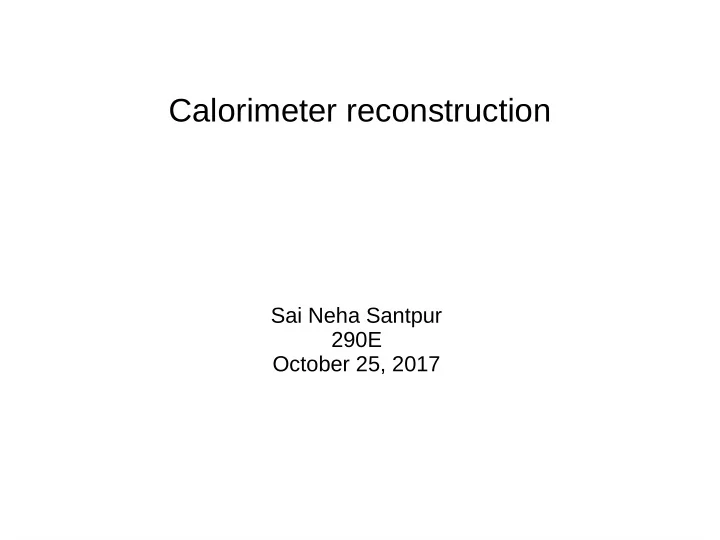

Calorimeter reconstruction Sai Neha Santpur 290E October 25, 2017
Outline ● Collisions at LHC ● Detectors and particle propagation ● Calorimeters ● Electromagnetic showers ● Jets ● Jet clustering algorithms
A collision at LHC ● A collision at the LHC is messy with a lot of particles shooting out ● We are interested in studying these particles and understanding the underlying physics ● In order to do this, we surround the interaction point with a detector that is capable of measuring and differentiating between different particles as best as we can
Detectors ● We will focus on ATLAS and CMS, which are the two multi- purpose detectors at LHC. ATLAS CMS
Particle propagation ● Tracker measures the momentum of the charged particles (more on them in Patrick’s presentation) ● Calorimeters measure the energy deposits ● These detectors act complimentary to each other
Calorimeters ● Energy is measured by total absorption and usually combined with spatial information (reconstruction) ● When a particle (jet) propagates through a material, it looses energy via bremsstrahlung, photon pair production, ionization, etc. ● We are interested in particles like electrons, photons and also hadrons like pions, kaons and also jets (a group of hadrons).
Electromagnetic calorimeter ● Electrons and photons loose energy by the creation of electromagnetic showers (bremsstrahlung and photon pair production) ● The characteristic interaction distance for an EM interaction depends is the radiation length X 0 and is dependent on the material ● At high energies, bremsstrahlung and photon pair production dominate and as energy falls below a critical energy, ionization dominates and eventually leads to the particle being stopped in the detector ● This results in longitudinal an transverse showers in the electromagnetic calorimeter
Calorimeter types ● Two types of calorimeters: – Homogeneous calorimeter ● Entire volume is sensitive. ● May be built with heavy scintillating crystals or non-scintillating Cherenkov radiators. Example: CMS electromagnetic calorimeter (PbWO 4 ) – Sampling calorimeter ● Metallic absorber sandwiched with an active medium. ● The active medium may be a scintillator, ionizing noble liquid, gas chamber, semiconductor or a Cherenkov radiator Example: ATLAS electromagnetic calorimeter (LAr with lead absorbers)
Jets ● Quarks can radiate gluons and gluons can generate quark-anti quark pairs in addition to radiating more gluons ● Due to color confinement, these should combine to form colorless hadrons ● Gluon radiation is dominant in the direction of initial parton ● This results in a bunch of hadrons traveling in roughly same direction ● As these hadrons are heavier, they reach the hadronic calorimeter ● You will end up getting a bunch of energy deposits nearby in the calorimeter that you can combine to form jets
Hits → Jets ● After a collision, you get a bunch of hits in the calorimeter that you need to combine to form jets ● At low energy experiments, it was easier to group the hits by eye balling ● However, at hadron colliders, we need sophisticated algorithms to cluster a bunch of hits together ● You can cluster hits based on the geometry ie. the angular separation or their energy deposits ● Lets look at a few jet clustering algorithms
A good jet algorithm ● Insensitive to pile up and underlying events ● Collinear and infrared safe ● Fast
k T algorithm ● Metric used for combination: ● It is a sequential recombination algorithm: Combine particles starting from closest ones and iterate the combination until no particles are left ● Use the above metric to calculate distance between different hits and combine the two with the least distance (if its below a fixed cut) and continue to do this until all hits are exhausted. ● Here, we start by combining the hits with lowest energy deposits ● As a result, the algorithm is susceptible to underlying event and pile up
Anti-k T algorithm ● Metric: ● This is also a sequential clustering algorithm ● Here, we start by combining hits with the highest energy deposits rather than softest as was done in k T algorithm ● This algorithm is hence not sensitive to underlying events and pile up
Other algorithms ● SIS-cone (purely cone based algorithm) ● Cambridge/Aachen (purely spatial but very good to study jet substructure) ● Comparison:
Summary ● Energy measurement is very important to study s the physics in a collision event. ● Clustering of energy deposits to obtain jets and particles is non trivial and a complicated procedure ● There are many details to jet clustering not discussed here ● These days we have tools to study the jet substructure in detail
References ● http://iopscience.iop.org/article/10.1088/1742-6596/645/1/01200 8/pdf ● JHEP 0804:063,2008 ● https://portal.uni-freiburg.de/jakobs/dateien/vorlesungsdateien/ wpf2hadroncollider/kap2c ● http://iopscience.iop.org/article/10.1088/1742-6596/293/1/01200 1/pdf ● 226 lecture slides: https://sites.google.com/lbl.gov/gray-ph226-2017/home ● https://atlas.cern/ ● https://cms.cern/
Recommend
More recommend